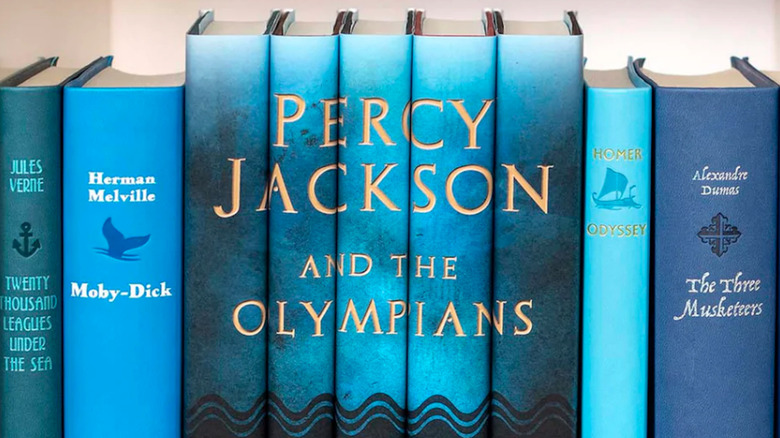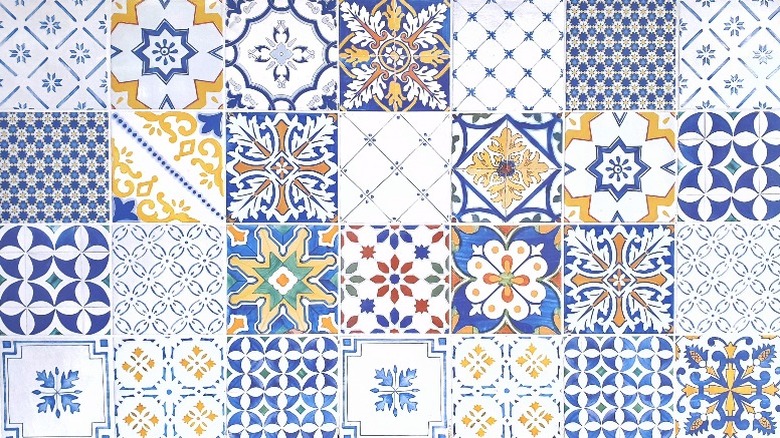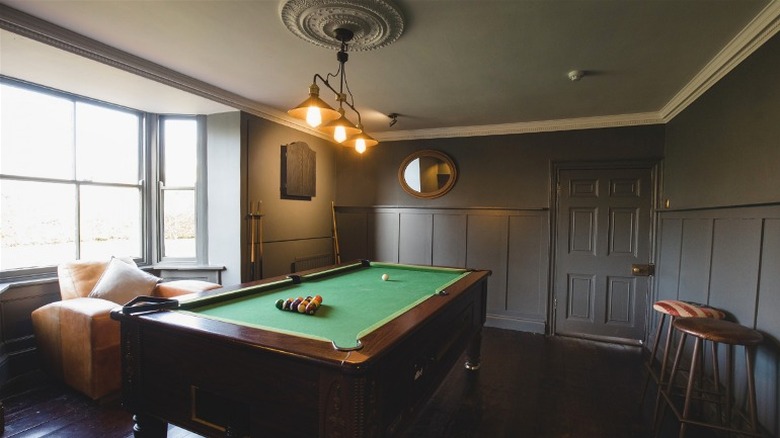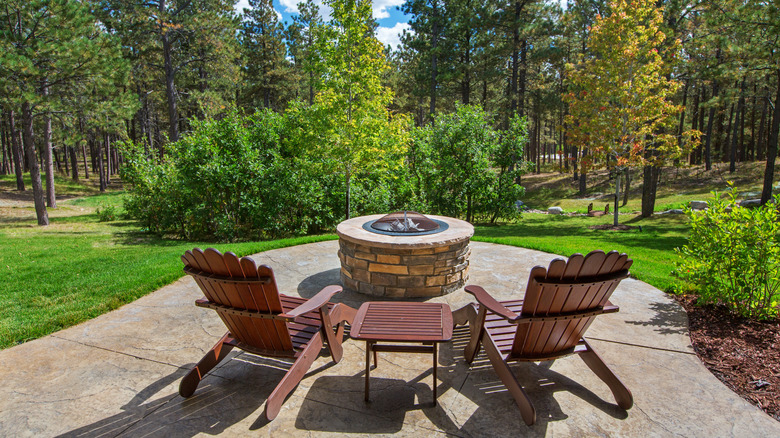5 Classy Ways To Incorporate Percy Jackson Into Your Home Decor
On the heels of best-selling author Rick Riordan's announcements regarding the two new novels that will be joining the Camp Half-Blood Chronicles next year, one of which is his first Percy Jackson-centric book in over a decade, it makes sense that fans would be in a bit of a frenzy (via Rick Riordan). And with the 20th anniversary of "The Lightning Thief" also nearing and the franchise further expanding with an upcoming Disney+ show, it makes even more sense that readers of all ages would want to bring as much of the stories into their home décor as possible.
But considering that the Chronicles are composed of more than 25 books, short stories, and graphic novels, pulling design inspiration from particular characters and moments within the plot is easier said than done. And although movie posters and merchandise may seem like a quick and simple solution to this, it's only scratching the surface when it comes to creatively capturing the magic and honoring the legacy of Riordan's stories. So what can one do instead?
Mosaic tiles
Prominent all over the world, the centuries-old art of laying mosaics has helped provide historians with insight into the artistic abilities of ancient civilizations and revealed what people's lives were like at those points in history (via World History Encyclopedia). And while these tiles haven't specifically been linked to Riordan's books, they are a good starting point for fans of Percy Jackson who want to further connect with the stories and embrace the Mediterranean style.
In terms of how the Greeks and Romans used them, the two civilizations each had their own design preferences when it came to mosaics, as the Greeks favored colorful materials, while the Romans opted for natural designs and muted tones. Despite their stylistic differences, both civilizations covered just about every surface with the tiles, including fountains, vaults, family heirlooms, and even the bathhouses that briefly appeared in "The Son of Neptune" following Percy's arrival at Camp Jupiter.
Mosaics today, however, seem to be used quite minimally as they generally appear in select locations such as kitchens and bathrooms. And although they've historically been composed of materials like pebbles and seashells, mosaic tiles are now available in a wide variety of colors and finishes. Nevertheless, readers can still follow in the footsteps of the Greeks and Romans by using the tiles in unexpected ways in their homes, like on their ceilings, while also referencing particular Olympians with their color and design choices.
Reading nooks & studies
While they might be ideal places to honor the Greek goddess of wisdom and strategy, reading nooks and studies additionally provide readers the opportunity to display their favorite themed décor. This may involve drawing on certain books, characters, or even plot points for inspiration, such as Thalia Grace in "The Sea of Monsters" with pine tree prints and fleece blankets as a reference to the Golden Fleece.
But if you can't decide on a particular character or moment to feature, highlighting some of the locations in the Camp Half-Blood Chronicles with maps is ideal. From the Long Island Sound and the Oakland Hills to New York City and Rome, the possibilities are endless. Additionally, you can expand your book collection with classics like Homer's "The Odyssey" and "The Iliad," as well as mythology-centric ones such as Edith Hamilton's "Mythology: Timeless Tales of Gods and Heroes" (via Amazon).
However, if you'd rather honor Athena herself in these spaces, you may want to consider decorating with baskets to reference the goddess' superior weaving skills while adding a bit of texture and extra storage. You can also want to reference her with a Grecian bust pot to honor the Athena Parthenos statue, which was retrieved in "The Heroes of Olympus" series. Like this one from Anthropologie, these types of pots are reminiscent of how the goddess was born from Zeus's mind.
Cozy bedroom
While the god of sleep has yet to appear in Riordan's books, Hypnos has been mentioned throughout the Camp Half-Blood Chronicles and was granted a cabin at the Greek camp following the Battle of Manhattan in "The Last Olympian." Described as more dangerous than the Ares cabin, the Hypnos' cabin is perfect for fans to pull inspiration from as its inviting interior includes a fireplace and an abundance of freshly made beds, complete with fluffy pillows and quilts.
To replicate the cabin's design and bring its relaxing vibes into your own bedroom, opt for color palettes full of calming blues, rich hues, and cozy neutrals. Fans can increase their sense of security and warmth in the space by utilizing natural materials such as wood, leather, and linen, as well as layering softer materials like rugs and blankets. Silk pillowcases and blackout curtains are ideal as they've both been found to improve the quality of one's sleep.
Furthermore, since cabin 15 was also filled with the comforting scent of fresh laundry to help evoke sleepiness, readers may want to try using reed diffusers and pillow mists, as specific scents have been found to promote better sleep (via Healthline). And as a homage to the olive trees of Greece and the poplar branch hanging above the cabin's fireplace, fans can additionally incorporate one of Studio Mcgee's ever-popular faux olive trees in their bedrooms' design.
Game room
Considering how important games are for the demigod camps, it makes sense for fans of the book series to have a game room of their own. As for where you find inspiration for such a room, it is best to draw upon the place where meetings occur, and big decisions are made at Camp Half-Blood. Known as the Big House, the farmhouse is home to many rooms, including the infirmary and the rec room, the latter of which is furnished with a ping pong table and a selection of chairs.
And like reading nooks, game rooms are perfect for displaying meaningful décor, and for fans of Riordan's books, decorating with vintage pennants from Oxford Pennant to reference Camp Half-Blood's capture the flag games may be the most ideal. In addition to the flags, Wayfair recommends ensuring that the room is family-friendly by incorporating activities like an indoor climbing wall to honor the one that's used for training at the camp, just without the lava.
Game rooms additionally offer up the opportunity to be a bit more playful with your design choices, which for fans of the series, may entail bringing some of Dionysus' flair to the space. To do so, readers should try incorporating the god of wine's style into the room by embracing bold patterns and colors, as the camp director was known for favoring loud Hawaiian shirts and his animal, the leopard, in his Greek form.
The great outdoors
While decorating the inside of your home may be your main priority, make sure you don't turn a blind eye when decorating your outdoor living spaces since many of Riordan's stories involve the great outdoors. So whether you have a few acres to work with or a small yard, taking inspiration from the camps can help elevate your property and make spending time outside even more enjoyable.
To do so, it's best to start by imagining your yard as an extension of Camp Jupiter, as its manicured grounds include New Rome, Temple Hill, and, most importantly, the Garden of Bacchus. Situated atop a hill, the garden overlooks the camp and features a canopy of grapevines, making it an ideal place to draw upon when piecing together a garden. As for which plants should be used, it's only right to honor the fields of Camp Half-Blood with strawberry bushes and vining plants like bougainvillea, jasmine, and moonflower per Lowe's.
And because the garden was filled with bees in "The Mark of Athena," consider adding some pollinator-friendly plants like marigolds, lavender, and oregano (via Homestead and Chill). Along with the abundance of flowering and fruiting plants, adding a pergola, a picnic table, and a fire pit will help you further embrace the Greek camp by referencing the dining pavilion's design and how demigods used fire to send food offerings to the gods.






